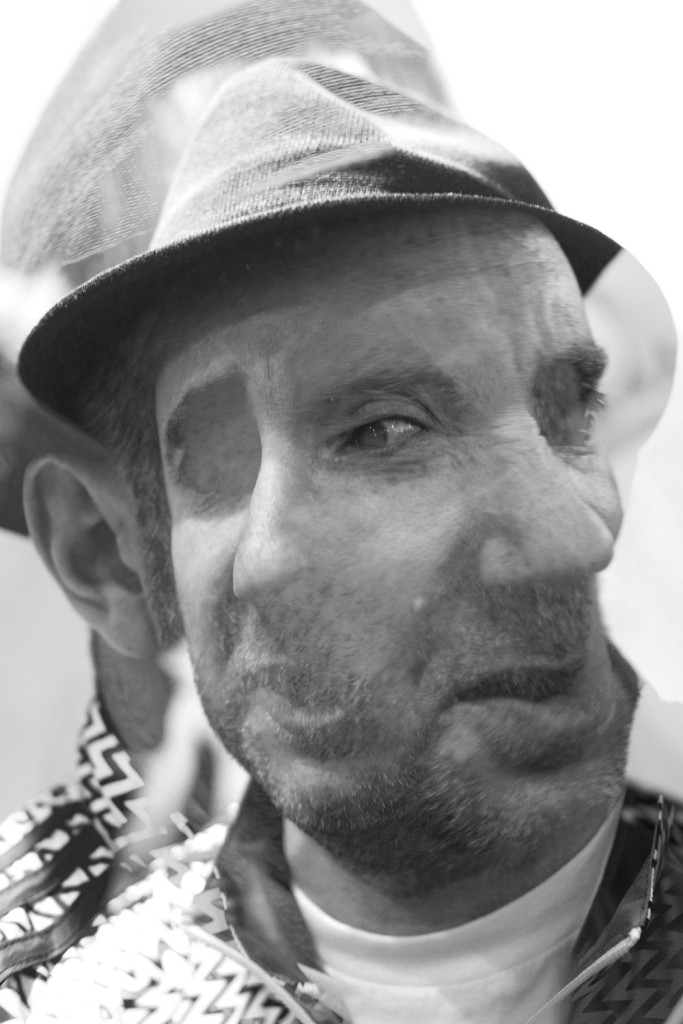採訪:SPITZ
撰文:ESSY CHIU
Paul Mittleman是Adidas Original的全球設計總監,在還未加盟Adidas之前,他在Stussy工作了二十個年頭。來自紐約的他,見證了從1980年代開始運動品牌影響街頭文化,及到今日又怎樣影響著高級時裝的歲月,他可說是collaboration(品牌與品牌之間的計劃)的先鋒,在街牌界中有著一定的影響力。早前他去到上海出席當地的一個大型街頭品牌活動, 我們籍著這個機會與他做了一個訪問。
Street Cred? All hail. Paul Mittleman hasn’t just been holding down the spot for streetwear; he might have damn near pioneered the genre. Paul goes back to the early days of Stussy. One of the first recruits to the legendary brand that birthed so many others. The native New Yorker has moved on up, and sideways, and now sits with the illustrious title of, ‘Global Design Director’, for the behemoth that is Adidas. Adidas Originals to be exact. So you know they’ve tapped him for his savvy in the game. We had a chance to sit down with the self-proclaimed, ‘inventor of the collaboration’, himself, and go through a bit of streetwear anthology with a fella that was involved with it from the giddy-up.
( English continued after CN )
SPITGAN – 可否說說你的背景。
PAUL MITTLEMAN – 在Adidas Original之前,我曾是Stussy的創意總監, 在那裡工作已有二十年,我可以說是首幾位發明了Collaboration的人。我之前沒有想過會成為Adidas的全球設計總監,所有事情都是很自然發生的,對我來說每天的工作都是一種挑戰。
SG – 你覺得今日的Adidas的形象如何?我這樣問是因為近年它與產品的水準有點不一……
P – 我覺得今日這個世界很多事物都走得太快,像Adidas Original今日變得有點與往日不一樣,因為很多人都希望它成為今日這個模樣。我不會說它會回復往日那種型格,因為以往的Original的形象太突出了,是時候走到另一個新的空間。是的,在生意方面我們做得很成功,盈利很高,但這有時卻會令人懶下來。你看今日很多小型品牌,他們反而會很努力創造新的產品出來,特別在digital方面做得很好,那怕只在家中做T恤設計的人,也可以紅起來。這在十年前根本沒有可能發生的,在這情況下,大型品牌更不可以因為做得成功步伐便慢下來,所以不久將來你會看到我們的新方向。
SG – 1980年代,是Adidas的高峰期,特別是Run DMC系列的出現,為民間帶來前所未有的狂熱街頭文化,但到1990年代,那種熱度似乎減褪了,是否因為有其他的品牌在街頭陸續出現?
P – 我覺得當年很多事物都在變,Adidas是第一個運動鞋履品牌,當年很多嘻哈樂手都以歐洲品牌為靈感。但突然在1980年代籃球圈出現了變化,很多人都說若果某一個運動員在當年簽了另一個品牌,往後很多事情都會變得不同。在當年另一個品牌在運動鞋方面又有出色的表現,這為市場帶來了很多良性競爭,每一個品牌都有它的長處。不同品牌的出現其實是需要的,不然的話這個世界會變得很悶。在1980年代運動界的市場推廣有著很大的變動,有大批資金投放在籃球員身上,又有大批資金投放在嘻哈樂手上,突然間運動鞋流行起來,籃球熱起來,嘻哈文化又熱起來,這些在當年都是叫人意想不到的。再後來街頭服流行起來,滑板服飾流行起來,日本品牌又紅起來。三十年後的今日我們還在這裏,Stussy 仍在,Supreme仍在,很多競爭對手還在,同時又有很多新的品牌出現,每個品牌都做得很好,因為這個市場有很多空間。
SG – 你的第一對Adidas是什麼?
P – 那是我母親買給我的Adidas Rom,那時我還很小,但對足球已十分著迷。而自己賺錢買的是Run DMC時期的Superstar。我一直住在紐約,所以我不能穿其他地區球星的球鞋,哈哈…所以我有一對Patrick Ewing的籃球鞋。這是我最重要的三雙運動鞋。
SG – 在這個龐大的公司工作,對你來說最具挑戰性的是什麼?
P – 在這麼龐大的公司工作當然有更大的責任,而我的背景與公司大部分的人很不同,我有一些特權,而其他人又有他們的特權,最重要的是將不同背景的人團結地工作,當然不是每一個人都可以融洽地相處。但我覺得只要你懂得尊重別人,你盡了你的責任完成你的工作,而且對人誠實的話,工作便不會有太大的問題,雖然誠實有時的霆會傷及別人的感覺。
SG – 你在學校修讀的是設計嗎?你怎樣進入這個行業的?
P – 我沒有修讀過任何設計的課程,只不過當年跟隨自己喜歡的東西而已,碰巧當時Stussy面世,我就是這樣開始進入這個行業。那時還沒有什麼街頭品牌存在,只有Stussy、Levis、Adidas、Carhatt等數個品牌。Stussy可以說是第一個帶起了街頭時裝文化,然後坊間看到了一些唱片封套上的音樂人穿著這些服飾,街頭時裝才開始在坊間流行起來。然後開始有不同的街頭時裝品牌出現,滑浪品牌又開始加入,又有日本品牌的出現,這些某程度上都是與Stussy有關連的。
你認為Adidas最cool最出色的是什麼?
我覺得是整個品牌的形象,當然最叫人熟悉的是三間。但我同時覺得,愈刻意設計的東西便愈虛假,愈刻意營造出來的型格便愈失真,通常那些刻意營造出來的型格最多只能維持幾個星期,而往往最cool的都是那些可以長久存在的東西。為了生意我們可以要做這些產品出來,但最有型的逍常都是最基本、最正常的東西。
SG – Y3鞋履系列呢?
P – 那是非常有創意的系列,Jeremy Scott做的亦然,誰會想到可以將一雙翅膀放在鞋上,我覺得Adidas最有趣的地方是大膽地與不同設計師及不同品牌合作,他會與Rick Owen合作,又找來Raf Simon,又會與其它的街頭品牌合作,有來自日本的,還有美國、英國品牌。特別是與Rick Owen及Raf Simon的合作,是很多人意料之外的,都是非常具突破性的。
SG – 有什麼高級時裝品牌你特別喜歡的?因為在Adidas Original的設計中,不難找到一些高級時裝的影子,特別是衣服的形態方面。
P – 我享受與他們合作,可我並不是對高級時裝擁有特別多的興趣。今日很多在高級時裝品牌工作的人,都是我一起長大的人,或是互相認識的,今日與昨日不一樣的是,你小時候只認識Karl Lagerfeld,我看Valentino的電影,我不認識Valentino,我只知道他是一個時裝設計師。Kim Jones與Raf Simon今日做得如此出色,但我也可能做得到呀,因為今日很多高級時裝屋的人都有曾經在街頭品牌工作過,又或曾在嘻哈、punk rock文化中混過,你不需要是天才都會看到誰在哪里找靈感。今時不同往日。你看Givenchy基本上是在做streetwear,只不過用料、造工較優良罷,這個狀態又有誰想得到呢?他們在我們這裏找靈感,我們又會參考他們,那有多好!祝各人好運。
SG – Adidas在可持績性這個議題方面參與了多少?
P – Adidas是一間非常環保的公司,在一個完美的世界下,我們當然希望所有產品都切合環保的條件,但可惜成本很高,亦不是每一個人都可以負擔得起高價格。但我們對這點保持高度警覺,我們盡所能去做得更好。除了產品上,我們在生產的過程中亦很嚴格,無論是在生產線,或是貨物的運送過程中,都盡所能去保護環境,這些是所有品牌的責任,特別是像Adidas這般龐大的公司,不論是保護環境、工人法律等這些社會責任等,都是不能避免的。
SG – 你的衣櫥中有什麼是超過五年的?
P – 我有很多超過二十年歷史的牛仔褲,還有T恤,因為稱身舒適。我會偏向穿新球鞋,但我不會穿二十雙球鞋。
( English Con’t )
SPITGAN – You are the global creative director of Adidas Originals? Men’s?
PAUL MITTLEMAN – Everyone’s business card says Global Design Director, but when you go to work you do men’s, women’s, running. Its a very flat platform. It’s very fair, because obviously some parts of the business are more profitable than others, so some designers have bigger responsibilities. All 30 of us, or 20 of us have the same job title.
SG – Tell us what are some of your responsibiliities?
P – My normal day to day is doing men’s footwear and apparel for Adidas Originals. Then from my background, since I come from another company and have a lot of experience in collaborations…
SG – You mean Stussy.
P – Yes. Since I was with Stussy for almost like 20 years, I’ve kind of invented collaborations. I don’t get so involved in the forefront, but I help quite a lot with making sure things are connecting.
SG – What are some of your personal goals and objectives in this position?
P – I have no idea. I never thought I would have this job. It wasn’t something I planned. I never thought I would move to Germany. So I kind of just go to work everyday. Its kind of mellow actually. Work is very serious but I never aspired to be a global director for a sportswear brand. They asked me, and I said, ‘sounds interesting’. Everyday is a new challenge.
SG – What is going on with your brand visually? Are you satisfied with it? I ask because I think of things like the Star Wars commercial in the tavern, which was very slick and clever, then you have some advertisements which lack the same…
P – …I just think the world has moved very fast since then, and Originals was a very different brand because the world wanted it to be. I wouldn’t say that its going to become slick again, but its about to go into…its almost Originals 2.0. Its kind of finding a new space for itself. The business is incredibly successful, and profitable, but sometimes that can make you not be as hungry. I would think you will start seeing a lot of things change. When you’re a big brand size of this size you can kind of get a bit lazy. Look at most of the brands at this event, YoHood street. They are very small brands. They make very interesting products. They are very good at digital media. You can be a young person at home making t-shirts now, and all of a sudden its the hottest thing in the world. That wouldn’t of been the case 10 years ago.
SG – Does it challenge or change your thinking now? You are working for this global monster.
P – No. I come from an entrepreneurial background. At Stussy I had to do the graphics, the t-shirts, the design, the PR. Not the business, they were smart to keep me away from that. I like to spend too much money.
SG – Hahah.
P – I know business, though. I did advertising there, collaborations. I think of everything as entrepreneurial. That helps. Its not about my designs (anymore). I have to help my designers to become better. I have to work with external designers to make sure they do things to fit the rules. Its like playing a sport, your training for something new. Your never ready to get hit in the jaw. (laughs)
SG – Since you’ve come on with Adidas, what artists have you personally been involved in signing? There’s Nikki Manaj, Big Sean..
P – I have nothing to do with that. I just supported that. Our musical relationships are done by a different team, usually out of Portland.
SG – Portland?
P – Yeah, the Portland office. I guess a lot of the music industry we would deal with would be out of America. That goes through our brand communications department. I’m supportive of it, I’ve worked on some of it but its not my job. I have no real opinion on it either. They do it for different reasons. Some of the music I really like, some of it I think is a good idea, some is not my thing. Those decisions are not meant for me.
SG – Adidas was adopted by Hip Hop very early on. It was reciprocated with the RUN-DMC line. It kind of had ‘the Juice’ early, but in the 90’s it kind of tapered off. Was that because of the rise of brands like Stussy, Cross Colours, Phat Farm…
P – Interesting. I think a lot of things changed.I think Adidas was the first sneaker brand. They have a huge back catalogue of really great shoes. I think for a lot of Hip Hop, it was a very aspirational brand because it was European. It had a remarkably successful run. Not to say it has not continued, but things changed. Take basketball in the 80’s. That, no one could predict. I mean, you could always say, ‘what if’, a certain player signed a contract with another brand; things changed. There’s another quite successful brand out there in footwear, which makes competition really good. One brand has it’s strength in certain things, and another brand has its strength certain things. I’d like to think you’d have to have a lot of brands, otherwise it would be quite boring. There was definitely a shift in the world of sports marketing in the 80’s. A lot of money was poured into basketball players. A lot of money got poured into Hip Hop. All of a sudden shoes got huge. Basketball players got huge. No one would have expected any of it to happen. You can look back in hindsight and say, “there was once one really huge rap act, which was probably the first super group of rap, then there were other ones. Ones from Queens, wore those shoes. We’re from Brooklyn so we’re gonna like that.” It’s just rap, and shoes, and streetwear. Your right. Then street brands became popular. Skate brands became popular, japanese brands…things happened ya’ know. 30 years later, we’re still here. The competative brands are still here. Everyone is doing fine. There’s room for everyone. Stussy’s going on 40. Supreme’s been around for 20 years. Out of nowhere there’s Been Trill, and Hood By Air. The world just changes. Having Clot here (at YoHood Shanghai). No one expected a brand that large out of China. Its interesting.
SG – Your first pair of Adidas?
P – My first pair was when I was very, very young. My mother bought them for me. They were Adidas Rom, ’cause back then I was really into football. At that point it was the cosmos, and rock stars wore them. That was a very important pair. It was much more expensive than the shoes which we could afford, but I really wanted them. The first pair I bought with my own money, was around the time of RUN-DMC. A pair of Superstars, and right after that Rivalries. Living in New York, I couldn’t wear the shoes from the other guy. I had to wear Patrick Ewing shoes. Those were kind of the most important shoes. After that if I liked a pair I bought them or I bought something else. Those were the 3 that I really remember.
SG – What are some of the challenges working for such a behemoth. You come from a somewhat more fluid culture.
P – Its obviously a big brand, with bigger responsibilities. Just to be kind of cool, and respectful. You have to get things done. I come from a very different background than everyone else. I’m quite priviledged, but they are also quite priviledged, because they’ve been there. Its getting everyone to work together, it doesn’t always work. It’s fine because not everyone gets along all the time. If you’re always repectful and do what you say you’d do, no one will ever fault you for being honest.
SG – Your background. Did you study design?
P – No. About when streetwear was starting, you just picked up things. You liked them, it was like, ‘lets start a company’. Stussy was that company at the time.
SG – You grew up in New York right?
P – Yeah, but I met them in New York.
SG – When you were coming up what were some big streetwear brands?
P – There were none. I’m before any streetwear brand. I mean, record labels had T-shirts but they were industry things. I mean there wasn’t streetwear. Funny enough, streetwear was Adidas, Carhartt, Levi’s, track suits, M65 jackets. There was no streetwear. There was stuff you saw on an album cover, and you were like, ‘oh, I want to dress like that guy’. Stussy was the first streetwear brand. In a way, Adidas, without knowing it was the first streetwear kind of culture, but that was happenstance. Then you have surf culture, Fuct, Fresh Jive. Then Supreme changed everything. You have the Japanese, Bathing Ape, Undercover; and it all connects to Stussy somehow.
SG – You think there will be a point of over-saturation?
P – Who’d have thought they would have a streetwear event in Shanghai? I think this event proves that its not even nearly there. People here, to think, if you were interested in something in 1985, these people weren’t even born! This is all new. You know they’ll start researching back…Sure. You’ll get old people saying that its over, but nothing’s ending.
SG – Hahah. The Ransom collaborations with Adidas.
P – That was before my time. I know them. They have worked with Stussy.
SG – Where do you think the ‘cool’ cache with Adidas lies?
P – I think in the brand. Its just in the 3 stripes. Sometimes the coolest stuff is the stuff that’s not designed. Something that they’ve made for 40 years and its still cool. Making something cool is just fake. It lasts for a few weeks. We do it as a business, we have to make new things, but the coolest stuff is kind of basic. You always go back to the normal stuff.
SG – I’m actually very impressed with the Y-3 shoe range.
P – The Y-3 shoe range is remarkably creative. Its not done out of Originals. Look at what Jeremy Scott’s done. Who’d have thought to put wings on shoes! I think that’s the amazing thing about Adidas. They let Jeremy Scott do that. They work with Y-3. They work with Raf Simons, with Rick Owens. That’s a pretty diverse group.
SG – Men’s fashion. These so called ‘high brands’. Anything you particularly enjoy?
P – I like looking at some of the stuff, but I’m not that interested in high fashion.
SG – You obviously see the appropriation of streetwear though.
P – Yeah, of course. The people doing high fashion now though, a lot of them are people I have grown up with. The people that run all these companies are people I know. I’m not necessarily friends with, mind you; I know. I know Karl Lagerfeld, but I’m not friends with him. I’ve known Kim Jones though for 15 years. The heads of every fashion house now, are basically people that have been into streetwear, or Hip Hop, or Punk Rock. Its a pretty big change. I mean, Givenchy is basically making streetwear. It’s a bit better made and a bit better quality, but who’d have thought that would have happened?
SG – You know what. Everyone looking in says that, but people on the inside won’t own up to it.
P – I can say that. Still its awesome. You don’t have to be a genius to see that they’re inspired by this, and we are inspired by them. Fine.
SG – Are re-issues killing the sneaker game?
P – Naw.
SG – What in your closet has stood the test of time?
P – I have a lot of jeans that are 20 years old. Shoes, I kind of always want to wear new ones. Dirty sneakers. I don’t wear dirty sneakers. Jeans are something I don’t get rid of. White t-shirts too. They fit and they’re comfortable. Shoes unless their proper shoes or hiking shoes; you can’t wear dirty sneakers! That just doesn’t work.
SG – Are you a big Hip Hop fan?
P – Yep. I grew up with it.
SG – What was one of the first songs that you heard. That brought you in?
P – Probably one of the first was Rapper’s Delight. It was like, what was it? Then I think RUN-DMC was the first thing like, ‘Wow, I have to go buy this’. Rapper’s Delight, I was young and it was on the radio. I didn’t know whether I should love it, or hate it, ’cause I grew up listening to Punk Rock. RUN-DMC, I was sold.
SG – Was there a hardcore to early streetwear culture like there was with Hip Hop? In the 80’s if you weren’t lyrically up to par people would test you. The battle etc.
P – No. it was more business. I’m sure there were some cool things, I’ve just forgotten about them. Stussy got globally accepted, and obviously it was very related to Reggae. I don’t know. I would say since this is business, the street credibility thing isn’t as much of an issue. It’s different.
SG – Are you aware of any China streetwear brands?
P – You know what. With the internet, you kind of know what your going to get before you get there. Its a bit depressing, but this whole event is kind of interesting. There’s no one thing like, that’s it! I would think this question would be easier to ask in 5 years from now when you see the next group of brands. I would be curious to see what this inspires. Right now this could be anywhere, New York etc.
SG – At Originals do you have any sustainability initiatives?
P – Yeah. Its a remarkably green company. Its built into the business plan.
SG – So all brands, all lines…
P – No, unfortunately not all. Environmentally consious sneakers and clothing cost more and not everyone can afford to pay more. We’re very aware of it and we do it wherever we can. Even if its not in the product. Its in the way the product is manufactured and the way the product is shipped. We are very, very strict with what factories we work with, and that we can control. Every factory is audited dozens of times before we even enter one. I think all brands should be respectful of that. Its easier said than done.
SG – That’s great because I can remember a time when a lot of news was making light of poor manufacturing conditions, harmful environmental practices…
P – …because a lot of the brands stepped up and said, ‘We agree with you. This is wrong.’ Its the truth. Things were done questionably.
SG – Nice, because when your producing like you are…
P – …and when its a large brand of this size you have to be respectful of the environment, labor laws, the way things are shipped. We are very aware of it.
SG – That’s not something you guys are outspoken about publicly.
P – No. There are somethings that we say that are made without dye’s, without washes but as a brand, and especially a German brand; Germany is very active. I believe by 2017, there will be no nuclear power plants in Germany. Its quite profitable to mess up the world but I don’t know if its a great business strategy.
SG – Will you re-issue the RUN-DMC line or better yet, continue it?
P – No. We’re doing something different. Can’t say what. Stay tuned. We’re actually about to start doing something new with them.
SG – Can you share with us a personal indulgence of yours, of which money is no object?
P – Ah naw. I believe sometimes it is in better taste to be private. Especially in a world where some people are not so fortunate. Its cool to be mellow about what I do.




Speak Your Mind